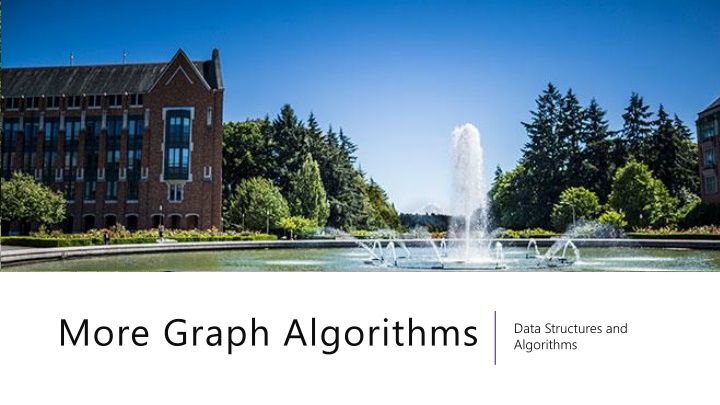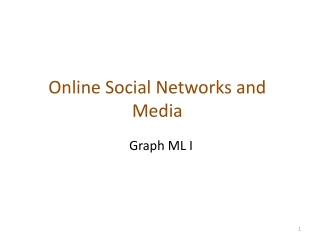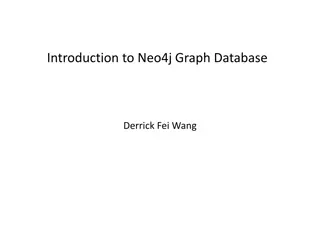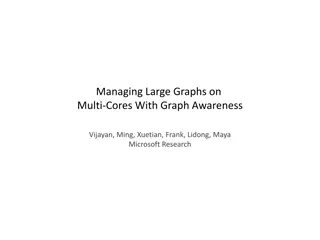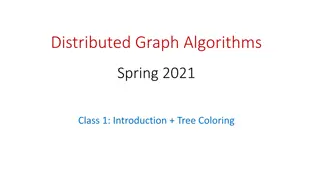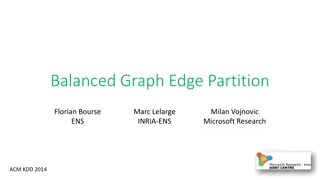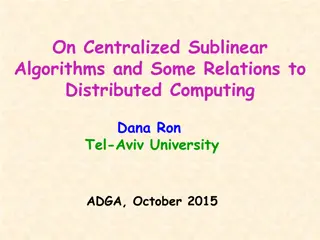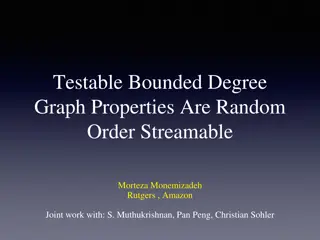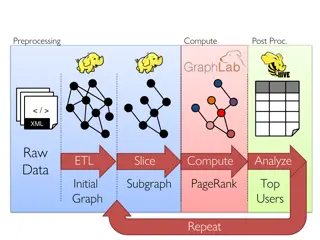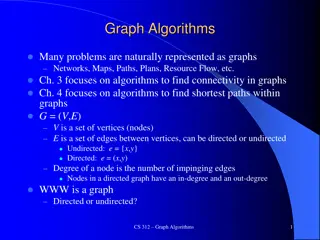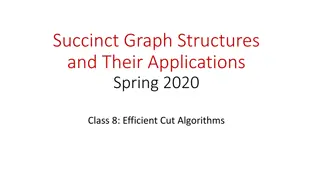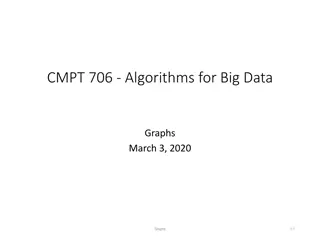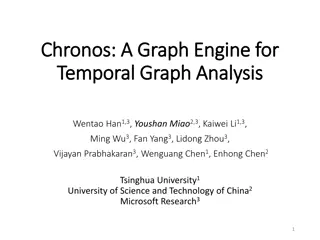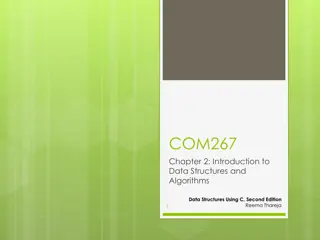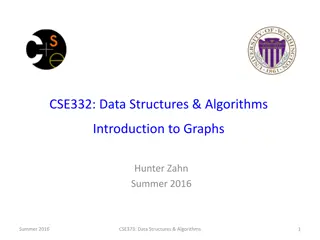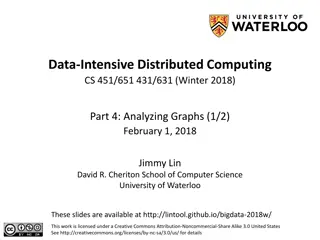Graph Algorithms and Data Structures Overview
Various graph algorithms such as Prim's Algorithm, Kruskal's Algorithm, and Minimum Spanning Trees, along with concepts like connected components and union-find. Dive into the world of graph theory, spanning trees, and efficient algorithms for graph traversal and optimization.
Download Presentation

Please find below an Image/Link to download the presentation.
The content on the website is provided AS IS for your information and personal use only. It may not be sold, licensed, or shared on other websites without obtaining consent from the author.If you encounter any issues during the download, it is possible that the publisher has removed the file from their server.
You are allowed to download the files provided on this website for personal or commercial use, subject to the condition that they are used lawfully. All files are the property of their respective owners.
The content on the website is provided AS IS for your information and personal use only. It may not be sold, licensed, or shared on other websites without obtaining consent from the author.
E N D
Presentation Transcript
More Graph Algorithms Data Structures and Algorithms
Announcements Talk on technical interviews today! Gugenheim 220 at 1:10 PM. today! Para Exercise feedback soon. P2 Feedback (hopefully) Saturday.
Announcements Please fill out course evaluations. They ll be helpful for me. They ll also be helpful for CSE/future students. Balancing preparing you for future courses and not overworking you is hard. Tell us the parts of the quarter that were particular pain points.
Minimum Spanning Trees It s the 1920 s. Your friend at the electric company needs to choose where to build wires to connect all these cities to the plant. B 6 3 E 2 1 C 10 A 9 5 7 4 D 8 She knows how much it would cost to lay electric wires between any pair of locations, and wants the cheapest way to make sure electricity from the plant to every city.
Prims Algorithm PrimMST(Graph G) initialize distances to mark source as distance 0 mark all vertices unprocessed foreach(edge (source, v) ) v.dist = weight(source,v) v.bestEdge = (source,v) while(there are unprocessed vertices){ let u be the closest unprocessed vertex add u.bestEdge to spanning tree foreach(edge (u,v) leaving u){ if(weight(u,v) < v.dist AND v not processed){ v.dist = weight(u,v) v.bestEdge = (u,v) } } mark u as processed } Running time: O(|V| log |V| + |E| log |V|)
Connected Component Connected Component Connected Component A set of vertices such that -There is a path between every pair of vertices -If you added any other vertex to the set, there would not be a path between every pair of vertices. {A,B,C,D} is not a connected component (could add E) {F,G,H} and {A,B,C,D,E} are connected components. E D B G H A F C
Kruskals Algorithm KruskalMST(Graph G) initialize each vertex to be a connected component sort the edges by weight foreach(edge (u, v) in sorted order){ if(u and v are in different components){ add (u,v) to the MST Update u and v to be in the same component } } How do we check the if statement? BFS would lead to an overall running time of ?(|?|(|?| + |?|))
Union-Find Crash Course Union-Find ADT aka Disjoint Sets Represents well disjoint sets. state state Set of Sets - Disjoint: Disjoint: No element appears in multiple sets - No required order - Each set has representative behavior behavior makeSet(x) creates a new set where the only member (and the representative) is x. findSet(x) looks up the set containing element x, returns representative of that set union(x, y) combines set containing x and set containing y. Picks new representative.
Union-Find Running Time We don t have time to talk about an implementation. Here s the important thing: Can do these operations in: Operation Operation Amortized Amortized MakeSet() Union() Find() Non Non- -amortized amortized (1) ?(log ?) ?(log ?) (1) (log?) (log?)
log? log ? the number of times you need to apply log() to get a number at most 1. E.g. log (16) = 3 log 16 = 4 log ? grows ridiculously slowly. log 1080 = 5. For all practical purposes these operations are constant time. log 4 = 2 log 2 = 1.
Using Union-Find Have each disjoint set represent a connected component. How do you see if two vertices are in the same component? - What happens when you add an edge?
Using Union-Find Have each disjoint set represent a connected component. How do you see if two vertices are in the same component? - find() on both -The representatives are the same if and only if the components are the same. What happens when you add an edge? -Union the two components
Now With Disjoint Sets KruskalMST(Graph G) foreach(Vertex v){ makeSet(v) } sort the edges by weight foreach(edge (u, v) in sorted order){ if(find(u) != find(v)){ add (u,v) to the MST union(u,v) } } Running Time? Dominated by sorting. ? ? log E .
Try it Out Edge Edge (A,B) (C,D) (B,F) (A,C) (C,E) (B,E) (A,D) (D,E) (D,F) (E,F) (B,G) Include? Include? Yes Yes Yes Yes Yes No No No No No Yes Reason Reason 50 G 6 B E 2 3 4 C 5 A 9 2 Cycle A,C,D,B,A Cycle A,D,C Cycle C,D,E Cycle A,B,F,D,C,A Cycle E,F,B,A,C,E 7 7 F D 8
Some Extra Comments Prim was the employee at Bell Labs in the 1950 s The mathematician in the 1920 s was Boruvka -He had a different also greedy algorithm for MSTs. -Boruvka s algorithm is trickier to implement, but is useful in some cases. -In particular it s the basis for fast parallel There s at least a fourth greedy algorithm for MSTs If all the edge weights are distinct, then the MST is unique. If some edge weights are equal, there may be multiple spanning trees. Prim s/Kruskal s are only guaranteed to find you one of them. parallel MST algorithms.
Aside: A Graph of Trees A tree is an undirected, connected, and acyclic graph. How would we describe the graph Kruskal s builds? It s not a tree until the end. It s a forest! A forest is any undirected and acyclic graph
Problem 1: Ordering Dependencies Today s next problem: Given a bunch of courses with prerequisites, find an order to take the courses in. CSE 331 Math 126 CSE 143 CSE 142 CSE 311 CSE 332
Problem 1: Ordering Dependencies Given a directed graph G, where we have an edge from u to v if u must happen before v. Can we find an order that respects dependencies respects dependencies? Topological Sort (aka Topological Ordering) Topological Sort (aka Topological Ordering) Given: Given: a directed graph G Find: Find: an ordering of the vertices so all edges go from left to right. Uses: Compiling multiple files Graduating.
Topological Ordering A course prerequisite chart and a possible topological ordering. CSE 331 Math 126 CSE 143 CSE 142 CSE 311 CSE 332 Math 126 CSE 331 CSE 332 CSE 311 CSE 142 CSE 143
Can we always order a graph? Can you topologically order this graph? A B C Directed Acyclic Graph (DAG) Directed Acyclic Graph (DAG) A directed graph without any cycles. A graph has a topological ordering if and only if it is a DAG.
Ordering a DAG Does this graph have a topological ordering? If so find one. C D A B E
Ordering a DAG Does this graph have a topological ordering? If so find one. C D A B E If a vertex doesn t have any edges going into it, we can add it to the ordering. More generally, if the only incoming edges are from vertices already in the ordering, it s safe to add.
How Do We Find a Topological Ordering? TopologicalSort(Graph G, Vertex source) count how many incoming edges each vertex has Collection toProcess = new Collection() foreach(Vertex v in G){ if(v.edgesRemaining == 0) toProcess.insert(v) } topOrder = new List() while(toProcess is not empty){ u = toProcess.remove() topOrder.insert(u) foreach(edge (u,v) leaving u){ v.edgesRemaining-- if(v.edgesRemaining == 0) toProcess.insert(v) } }
Whats the running time? TopologicalSort(Graph G, Vertex source) count how many incoming edges each vertex has Collection toProcess = new Collection() foreach(Vertex v in G){ if(v.edgesRemaining == 0) toProcess.insert(v) } topOrder = new List() while(toProcess is not empty){ u = toProcess.remove() topOrder.insert(u) foreach(edge (u,v) leaving u){ v.edgesRemaining-- if(v.edgesRemaining == 0) toProcess.insert(v) } } Running Time: ?( ? + ? )
Directed Graph Connectedness Strongly Connected: Strongly Connected: Can get from every vertex to every other and back! A D E B C Weakly Connected: Weakly Connected: Could get from every vertex to every other and back, if you ignore the direction on edges. A D E B C Disconnected: Disconnected: Can t get from every vertex to every other and back, even if you ignore the direction on edges. A D E B C
Strongly Connected Components Strongly Connected Component Strongly Connected Component A set of vertices C such that every pair of vertices in C is connected via some path in both directions, in both directions, and there is no other vertex which is connected to every vertex of C in both directions. A D E B C SCCs: {A}, {B,C,D,E}
Strongly Connected Components Problem K A B D E C F J
Strongly Connected Components Problem K A B D E C F J {A}, {B}, {C,D,E,F}, {J,K} Strongly Connected Components Problem Strongly Connected Components Problem Given Given: A directed graph G Find Find: The strongly connected components of G
SCC Algorithm Ok. How do we make a computer do this? You could: -run a BFS from every vertex, -For each vertex record what other vertices it can get to -and figure it out from there. But you can do better. There s actually an O(|V|+|E|) algorithm!
An Important Subroutine There s a second way to traverse a graph. Depth First Search -Won t find you shortest paths -But does produce interesting information about what vertices you can reach.
Depth First Search (DFS) BFS uses a queue to order which vertex we move to next Gives us a growing frontier movement across graph Can you move in a different pattern? What if you used a stack instead? bfs(graph) toVisit.enqueue(first vertex) mark first vertex as visited while(toVisit is not empty) current = toVisit.dequeue() for (V : current.neighbors()) if (v is not visited) toVisit.enqueue(v) mark v as visited finished.add(current) dfs(graph) toVisit.push(first vertex) mark first vertex as visited while(toVisit is not empty) current = toVisit.pop() for (V : current.neighbors()) if (V is not visited) toVisit.push(v) mark v as visited finished.add(current)
Depth First Search dfs(graph) toVisit.push(first vertex) mark first vertex as visited while(toVisit is not empty) current = toVisit.pop() for (V : current.neighbors()) if (V is not visited) toVisit.push(v) mark v as visited finished.add(current) F J G D A I H E B C B E H G F I C D A F G H E Current node: Stack: Finished: D BE C I A B H G F I C D
DFS Running time? -Same as BFS: ?( ? + ? ) You can rewrite DFS to be a recursive method. Use the call stack as your stack. No easy trick to do the same with BFS.
SCC Algorithm Ok. How do we make a computer do this? You could: -run a BFS from every vertex, -For each vertex record what other vertices it can get to -and figure it out from there. But you can do better. There s actually an O(|V|+|E|) algorithm!
SCC Algorithm I only want you to remember two things about the algorithm: -It is an application of depth first search. -It runs in linear time The problem with running a [B/D]FS from every vertex is you recompute a lot of information. The time a vertex is popped off the stack in (recursive) DFS contains a smart ordering to do a second DFS where you don t need to recompute that information.
SCC Algorithm K A B D E C F J If we run a DFS from A and another one from B, we ll go through almost the entire graph twice. Starting at J or K and moving from right to left will let us avoid recomputation. Details at end of this slide deck. For the final, we might ask you to find Strongly Connected Components, but won t require you use the algorithm.
Why Find SCCs? Graphs are useful because they encode relationships between arbitrary objects. Let s build a new graph out of the SCCs! Call it H -Have a vertex for each of the strongly connected components -Add an edge from component 1 to component 2 if there is an edge from a vertex inside 1 to one inside 2. D B E A K 1 2 F C J 4 3
Why Find SCCs? D B E A K 1 2 F C J 4 3 That s awful meta. Why? This new graph summarizes reachability information of the original graph. -I can get from A (of G) in 1 to F (of G) in 3 if and only if I can get from 1 to 3 in H.
Why Must H Be a DAG? H is always a DAG (do you see why?).
Takeaways Finding SCCs lets you collapse If (and only if) your graph is a DAG, you can find a topological sort of your graph. Both of these algorithms run in linear time. Just about everything you could want to do with your graph will take at least as long. You should think of these as almost free preprocessing almost free preprocessing of your graph. -Your other graph algorithms only need to work on -topologically sorted graphs and -strongly connected graphs. collapse your graph to the meta-structure.
A Longer Example The best way to really see why this is useful is to do a bunch of examples. You d need to take 421 first. The second best way is to see one example right now... This problem doesn t look like it has anything to do with graphs -no maps -no roads -no social media friendships Nonetheless, a graph representation is the best one.
Example Problem: Final Creation We have a list of types of problems we might want to put on the final. -ForkJoin code, Hash tables, B-Trees, Graphs, To try to make you all happy, we might ask for your preferences. Each of you gives us two preferences of the form I [do/don t] want a [] problem on the final * We ll assume you ll be happy if you get at least one of your two requests. Final Creation Problem Final Creation Problem Given Given: A list of 2 preferences per student. Find Find: A set of questions so every student gets at least one of their preferences (or accurately report no such question set exists). *This is NOT how I m making the final.
Final Creation: Take 1 We have Q kinds of questions and S students. What if we try every possible combination of questions. How long does this take? O(2??) If we have a lot of questions, that s really really slow.
Final Creation: Take 2 Each student introduces new relationships for data: Let s say your preferences are in the top table: Yes! BTree Hash Problem Problem B-Tree Hash Table Graph Fork Join YES YES NO X NO X Yes! Yes! FJ Yes! graph Problem Problem B-Tree Hash Table Graph Fork Join YES YES NO NO X NO FJ NO graph NO BTree NO Hash X If we don t include a B-Trees, can you still be happy? If we do include a hash tables can you still be happy?
Final Creation: Take 2 Each student introduces new relationships for data: Let s say your preferences are represented by this table: Yes! BTree Hash Problem Problem B-Tree Hash Table Graph Fork Join YES YES NO X NO X Yes! Yes! FJ Yes! graph Problem Problem B-Tree Hash Table Graph Fork Join YES YES NO NO X NO FJ NO graph NO BTree NO Hash X If we don t include a B-Trees, can you still be happy? If we do include a hash tables can you still be happy?
Final Creation: Take 2 Hey we made a graph! What do the edges mean? -We need to avoid an edge that goes TRUE THING FALSE THING Let s think about a single SCC of the graph. NO E NO C NO B Yes B Yes A
Final Creation: SCCs The vertices of a given SCC must either be all true or all false. Algorithm Step 1: Algorithm Step 1: Run SCC on the graph. Check that each question- type-pair are in different SCC. Now what? Every SCC gets the same value. -Treat it as a single object! We want to avoid edges from true things to false things. - Trues seem more useful for us at the end. Is there some way to start from the end? YES! Topological Sort
